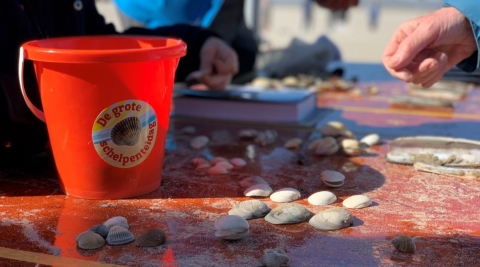The Big Seashell Survey shows remarkable differences between Belgium and the Netherlands
Saturday 19 March 2022, about 750 citizens collected more than 38.000 shells on Belgian beaches, with a top-5 in line with the results of the 2021 edition. For the first time, the Netherlands joined this citizen science initiative and collected another 22.000 shells, showing remarkable differences between both countries.

The Flanders Marine Institute (VLIZ) and its partners (EOS wetenschap, Natuurpunt, Provincie West-Vlaanderen, Strandwerkgroep, Kusterfgoed, the ten coastal municipalities) joined forces for the fifth edition of the Big Seashell Survey, a well-established LifeWatch Belgium citizen science initiative.
On 19 March in the bright sun, 750 citizens collected, counted and identified 38,000 beach shells, with the help of more than eighty mollusk experts. For the first time, the Netherlands – Naturalis, NMV, Stichting Anemoon, Stichting De Noordzee and the Strandwerkgemeenschap – stepped in and collected another 22,000 shells on seven beaches in the Dutch province of Zuid-Holland and on one Texel beach. In both countries together, 60 different species have been registered, with two out of three species shared by Belgium and the Netherlands. Non-indigenous species accounted for ten percent of all specimens and species.
In addition, scientists discovered remarkable differences between the two countries. Belgium recorded a top-5 comparable to the result of the 2021 edition (Baltic tellin 37%, Cut trough shell 22%, Edible cockle 18%, Blue mussel 9% and Atlantic razor clam 5%), whereas on Dutch beaches there was a clear dominance of Spisula shells, with 49% Cut trough shells, 9% Elliptical trough shell and 6% Thick trough shell. Here, Atlantic razor clam (9%) and the Edible cockle (8%) completed the top-5. One explanation for the high number of Cut trough shells on Dutch beaches could be the slightly different hydrographic conditions with more exposure, in favor of this shell.
“Another difference appears to relate to the vicinity of the Scheldt estuary”, says Jan Seys (VLIZ). “The mouth of this estuary, next to the eastern part of the Belgian coast, contains more silt and clay then the sandier Zuid-Holland and Flemish west coasts, and it has quite some peat banks in and on top of the sea-bottom. This silty environment is a perfect environment for the Baltic tellin; the peat banks can house American and white piddocks”. At the Dutch coast, the Baltic tellin ended up in a eight position, accounting for only 2% of all shells. And in the Netherlands, boormosselen did not end up in the top-10, whereas piddocks at the eastern part of the Belgian coast were much more common (9% of all shells).”
Photo: VLIZ | Annelies Tavernier
On 19 March in the bright sun, 750 citizens collected, counted and identified 38,000 beach shells, with the help of more than eighty mollusk experts. For the first time, the Netherlands – Naturalis, NMV, Stichting Anemoon, Stichting De Noordzee and the Strandwerkgemeenschap – stepped in and collected another 22,000 shells on seven beaches in the Dutch province of Zuid-Holland and on one Texel beach. In both countries together, 60 different species have been registered, with two out of three species shared by Belgium and the Netherlands. Non-indigenous species accounted for ten percent of all specimens and species.
In addition, scientists discovered remarkable differences between the two countries. Belgium recorded a top-5 comparable to the result of the 2021 edition (Baltic tellin 37%, Cut trough shell 22%, Edible cockle 18%, Blue mussel 9% and Atlantic razor clam 5%), whereas on Dutch beaches there was a clear dominance of Spisula shells, with 49% Cut trough shells, 9% Elliptical trough shell and 6% Thick trough shell. Here, Atlantic razor clam (9%) and the Edible cockle (8%) completed the top-5. One explanation for the high number of Cut trough shells on Dutch beaches could be the slightly different hydrographic conditions with more exposure, in favor of this shell.
“Another difference appears to relate to the vicinity of the Scheldt estuary”, says Jan Seys (VLIZ). “The mouth of this estuary, next to the eastern part of the Belgian coast, contains more silt and clay then the sandier Zuid-Holland and Flemish west coasts, and it has quite some peat banks in and on top of the sea-bottom. This silty environment is a perfect environment for the Baltic tellin; the peat banks can house American and white piddocks”. At the Dutch coast, the Baltic tellin ended up in a eight position, accounting for only 2% of all shells. And in the Netherlands, boormosselen did not end up in the top-10, whereas piddocks at the eastern part of the Belgian coast were much more common (9% of all shells).”
Photo: VLIZ | Annelies Tavernier



